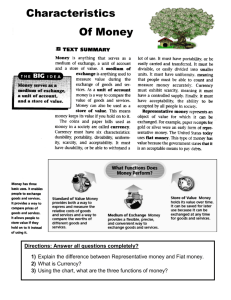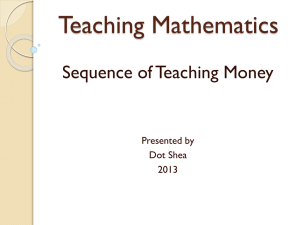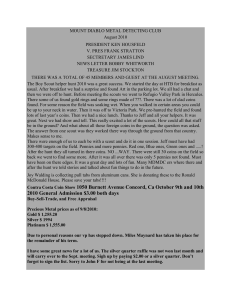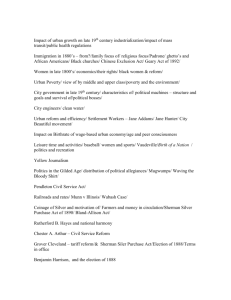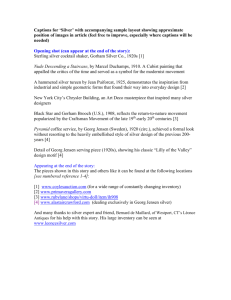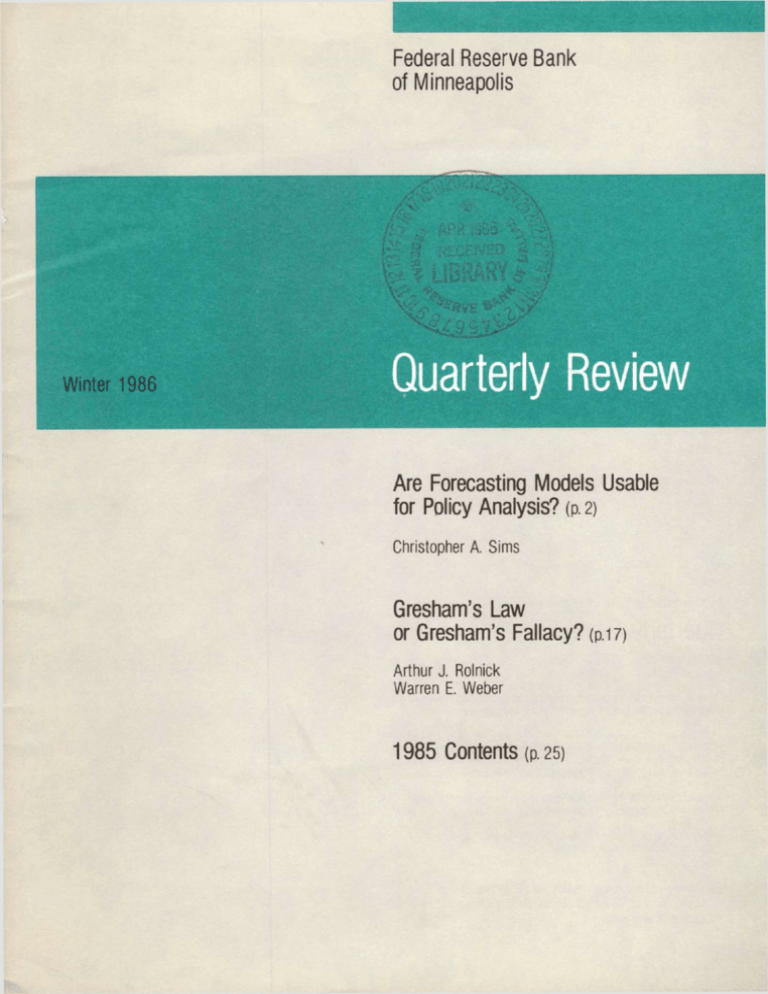
Federal Reserve Bank
of Minneapolis
Are Forecasting Models Usable
for Policy Analysis? (p. 2)
Christopher A. Sims
Gresham's Law
or Gresham's Fallacy? (p.17)
Arthur J. Rolnick
Warren E. Weber
1985 Contents (p. 25)
Federal Reserve Bank of Minneapolis
Quarterly Review
Vol. 10, No. 1
ISSN 0271-5287
This publication primarily presents economic research aimed at improving
policymaking by the Federal Reserve System and other governmental
authorities.
Produced in the Research Department. Edited by Preston J. Miller, Kathleen
S. Rolfe, and Inga Velde. Graphic design by Phil Swenson and typesetting
by Barb Cahlander and Terri Desormey, Graphic Services Department.
Address questions to the Research Department, Federal Reserve Bank,
Minneapolis, Minnesota 55480 (telephone 612-340-2341).
Articles may be reprinted if the source is credited and the Research
Department is provided with copies of reprints.
The views expressed herein are those of the authors and not
necessarily those of the Federal Reserve Bank of Minneapolis or
the Federal Reserve Systemi
Federal Reserve Bank of Minneapolis
Quarterly Review Winter 1986
Gresham's Law or Gresham's Fallacy?*
Arthur J. Rolnick
Senior Vice President and
Director of Research
Warren E. Weber
Senior Economist
Research Department
Federal Reserve Bank of Minneapolis
If a mint issues two distinct types of silver dollars, one
containing, say, half as much silver as the other, will both
coins be used as a medium of exchange? According to the
popular version of Gresham's law—perhaps the most
generally accepted and frequently cited proposition in
economics—the answer is no; only one of the coins will
circulate because bad money drives out good. In this case
that means the lighter-weight silver dollar (bad because
overvalued at the mint) will circulate while the heavierweight coin {good because undervalued at the mint) will
be hoarded.
Not all proponents of Gresham's law would agree with
that answer, however. Many would likely say instead that
to determine what happens to our two silver dollars they
need more information, for they favor a more careful
version of the law, one that includes an important
qualification. Bad money drives out good, according to
this version, but only when the ratio of the face (or par)
values of the monies (the par price) is somehow the fixed
rate at which these monies exchange. When that qualifier
is true and the par price of the two monies differs from
their market price, the good money disappears because
selling it at its intrinsic value is more profitable than using
it at face value as a medium of exchange. (See, for
example, Friedman and Schwartz 1963, p. 27, n. 16.)
Neither of these versions of Gresham's law is adequate to answer our question about silver dollars or the
more general question about what happens when the par
and market prices of two monies differ. The short version
of the law is simply contradicted by history. There have
been many periods when bad money has not driven out
good, periods when undervalued currency has instead
circulated side by side with overvalued currency. But the
qualified version of the law is not adequate either. It
cannot explain the numerous exceptions to the popular
dictum or predict a general result because it relies on the
existence of a fixed rate of exchange that is different from
the market price. We have found no evidence that such a
fixed rate of exchange ever existed, and that is not
surprising since it is hard to believe it ever could exist. If
such a rate ever were managed—through a mint policy or
a legal tender law, for example—it would imply potentially unbounded profits for currency traders at the
expense of a very ephemeral mint or a very naive public.
We propose a more feasible qualification to the
popular version of Gresham's law, one that depends on
fixed transaction costs rather than a fixed rate of exchange. Bad money will drive good money out of
circulation, we argue, but only when use of the good
money at its market (nonpar) price is too expensive.
Generally, since small change is expensive to use at a
nonpar price, we expect small denominations of the
money undervalued at the mint to be scarce while large
denominations circulate at a premium. History seems to
support our new version of Gresham's law.
*Reprinted with permission from the Journal of Political Economy, 1986,
vol. 94, no. 1. © 1 9 8 6 by The University of Chicago. All rights reserved.
0022-3808/86/9401-0006S01.50. Originally written for the National Bureau of
Economic Research Conference on Macroeconomics held July 7 and 8,1983, in
Cambridge, Massachusetts. Weber was at Virginia Polytechnic Institute and State
University when the paper was written. The authors thank Tom Sargent, Neil
Wallace, Fischer Black, and Frederic Mishkin for helpful comments.
17
Gresham's L a w — T w o Inadequate Versions
First we describe several historical episodes that contradict the popular, unqualified version of Gresham's law.
(For a variety of instances in which that version of the law
appears to work, see Laughlin 1903, pp. 423-28.) We
then consider in detail the argument that these are not true
exceptions to Gresham's law because they do not take
account of the fixed rate of exchange qualification.
Some Historical
Exceptions
Finding exceptions to the popular version of Gresham's
law is not difficult. Examining only the nineteenthcentury U.S. experience and one seventeenth-century
English experience with bimetallism, we discover several
instances where bad money did not drive out good. What
makes these exceptions so damaging to the proposition is
that they occurred during periods for which Gresham's
law is often cited.
• 1792-1853—Two
U.S. Exceptions
The period between 1792 and 1853 contains two clear
exceptions to Gresham's law. One is the U.S. experience
with the Spanish milled dollar. This was a heavier coin
than the U.S. silver dollar, containing about 373.5 grains
of pure silver compared with 371.25 grains in the U.S.
dollar, and over this period it had legal tender standing.
However, it was not driven out of circulation. The
Spanish dollar was popular in the U.S. colonial period
and remained current at least until the dramatic increase
in world gold production in the late 1840s. Laughlin
(1896, p. 54) estimates that there were over 5 million
Spanish dollars and parts of dollars in 1830,22 percent of
the value of all coins circulating in the United States.
From 1792 to 1811, Taxay (1966, p. 125) reports, the
Spanish dollar circulated at a premium over the U.S.
dollar, a premium ranging from 0.25 percent to 1 percent.
It continued to circulate at a premium in later years,
according to William H. Crawford, secretary of the
Treasury in 1819 (quoted in Laughlin 1896, p. 53, n. 1):
"Spanish milled dollars compose the great mass of
foreign silver coins which circulate in the United States,
and generally command a premium when compared with
the dollar of the United States." In this instance, the bad
money (U.S. silver coins) failed to drive out the good
(Spanish dollars). Instead of being exported or hoarded,
this good money circulated at a premium.
The other exception to Gresham's law during this
period involves just monies coined by the U.S. mint.
These were gold and silver coins, whose relative status (as
good and bad money) in these years changed. This
change provides a test of Gresham's law that it appears to
fail.
18
For its first 42 years, the U.S. mint overvalued silver.
On April 2, 1792, Congress passed a coinage act establishing a national mint and authorizing the issuance of
gold and silver coins.1 The act established a ratio of 15 to 1,
the par price, between silver and gold coins, which was
the market price in 1792. Soon after the passage of the act,
however, the market price for gold rose, and it remained
higher than the par price until June 24, 1834, when the
second major coinage act raised the par price to 16 to 1.
Between mid-1792 and mid-1834, therefore, gold was the
undervalued (good) money and silver was the overvalued
(bad) money.
After mid-1834 and until the early 1850s, when
Congress reduced the silver content of all small-denomination coins, the status of gold and silver currency was
reversed. The ratio of 16 to 1 was higher than the market
price for gold and remained so for the rest of the century.
Thus gold became the mint's overvalued money and
silver the undervalued.
Gresham's law would predict from these facts that the
only current coinage would be silver before 1834 and gold
thereafter. But the Gresham's law prediction would be
wrong.
Between 1793 and 1846,2 the U.S. mint coined a
substantial amount of undervalued bullion. The accompanying table presents the dollar values of gold and silver
coins minted during the two subperiods. When gold was
undervalued at the mint (1793-1833), 25 percent of the
coinage was still gold; when silver was undervalued at the
mint (1834-46), nearly half—45 percent—of the coinage
was silver. If there was an obvious profit to be made
coining silver and melting gold coins before 1834 and
coining gold and melting silver coins thereafter, the
opportunities do not appear to be reflected in U.S.
coinage statistics.3
iGold coins were issued in the larger denominations,the largest being the
$ 10 coin, the eagle, and the smallest being a quarter eagle. Silver coins were issued
in the smaller denominations: the half disme (comparable to our nickel), the disme
(comparable to our dime), the quarter, the half-dollar, and the dollar. The act also
allowed individuals to bring unlimited amounts of gold and silver bullion to the mint
and have it coined without charge; if they demanded immediate exchange, a charge
of 0.5 percent would be levied.
2 The dramatic increase in world gold production in the late 1840s led to large
amounts of gold being coined at the U.S. mint. Since Gresham's law cannot be
credited with the discoveries that led to the increased gold production, we consider
the coinage data only through 1846.
3 Proponents of Gresham's law might argue that even though gold was minted
it never circulated; it was only exported to countries that valued gold by weight.
However, estimates of exported coins before 1834 suggest that roughly the same
dollar amount of silver was exported as gold. Data on gold and silver exports as of
January 1, 1834, and on annual gold prices and gold and silver coinage are contained in an Appendix that is available from the authors on request.
Arthur J. Rolnick, Warren E. Weber
Gresham's Law
U.S. Coinage of Gold and Silver, 1793-1846
Percentages of
Total Minted
Dollar Values
Period
1793-1833
Total
Gold
Silver
Gold
Silver
$48,100,975
$1 1,825,892
$36,275,083
25%
75%
$73,331,479
$40,534,060
$32,797,419
55%
45%
(Gold Undervalued)
1834-46
(Silver Undervalued)
Source of basic data: U.S. Department of the Treasury 1981, pp. 16-17, 2 5 - 2 7
• Two Later Nineteenth-Century
U.S. Exceptions
Continuing on in U.S. history, we find two more exceptions to the simple version of Gresham's law, most
notably, experiences during the early part of the greenback
era (1862—79) and the time just after the Bland-Allison
Act of 1878.
Greenbacks were legal tender notes issued by Congress to help finance the Civil War. To be consistent with
Gresham's law, they should have driven both gold and
silver out of circulation, for greenbacks were the bad
money of their day. By the act of February 25, 1862,
Congress was authorized to issue $150 million worth of
greenbacks. The two subsequent acts of July 11, 1862,
and March 3,1863, authorized an additional $300 million.
Because of speculation on the outcome of the war and
resumption, the gold price of these notes fellfromtheir par
value when first issued to 91 cents on the dollar
by June 27, 1862, and to 84 cents by July 22,1862. Six
months later it had fallen to 68 cents, and by July 22,
1864, it had fallen below 40 cents. (For a complete list of
daily price quotes for greenbacks, see Mitchell 1903,
Appendix A, Table 2.) Over most of the early Civil War
years, therefore, specie was the undervalued money and
greenbacks were the overvalued money (in this instance,
overvalued by the U. S. Treasury, which was accepting all
legal tender money at par).
Did greenbacks drive out specie? Some textbooks
claim they did (Prager 1982, p. 32, for example), but
Moses, writing in 1892, makes it clear that in the West,
despite the presence of greenbacks, gold remained the
unit of account and a medium of exchange. He says that a
contributor to the San Francisco Daily Herald wrote
that greenbacks were also current there, but at a discount
(Moses 1892, p. 18): " A writer in this journal, February 16,1863, found very little difficulty arising from the
use of legal tender notes; for they had a market value, and
most people were ready to receive them at that value." In
the East it appeared that the money system was reversed.
There, according to Moses (1892, p. 15), greenbacks
were accepted as the unit of account and specie circulated
at a premium.
The other nineteenth-century U. S. example we present
that contradicts Gresham's law is the coexistence of the
trade and Bland dollars in the early 1880s. Both of these
were U.S. silver dollars, but the lighter-weight Bland
dollar failed to drive out the heavier-weight trade dollar.
The trade dollar was authorized by the U.S. coinage
act of 1873 for a very specific purpose: to increase trade
with China, a nation that particularly favored silver. The
act authorized the minting of dollars containing 420
grams of silver, more than any other silver coin in
existence, and by 1878 close to 36 million had been
minted. Because Congress had intended the trade dollar
only for export, it revoked the trade dollar's legal tender
status in 1876. Nevertheless, in 1877 many of these
dollars were circulating in the United States.
In 1878, under the Bland-Allison Act, Congress
authorized the minting of another silver dollar, the socalled Bland dollar. (Congress had suspended the minting
of all silver dollars except the trade dollar in 1873.) The
new dollar was to contain less silver than the trade dollar
(only 412.5 grams), but it was given legal tender status.
19
The mint was allowed to issue from 2 million to 4 million
such dollars per month; within two years almost 50
million had been coined.
By 1880, therefore, the United States had two silver
dollars of different weight. If Gresham's law had been
operative, the trade dollar should have disappeared. In
fact, both coins circulated (Laughlin 1896, pp. 255-58).
The Bland dollar was current at par; the trade dollar
apparently circulated at its gold price, which varied
around 93 cents. Contrary to Gresham's law, the lighterweight Bland dollar not only failed to drive out the
heavier-weight trade dollar but also managed to circulate
at a higher price than the heavier-weight dollar.
• One Irresistible English
Exception
Finding exceptions to Gresham's law in nineteenthcentury U.S. history has not been very hard. Although we
suspect that many more exceptions could be found in
other periods as well as in other countries, we did not
investigate all the possibilities. The examples we have
described are enough to make our point that bad money
does not necessarily drive out good money. We did,
however, come across one other exception that deserves
mentioning because it is such an obvious contradiction to
the popular version of Gresham's law. This exception
occurred in seventeenth-century England, when the English mint began producing a new gold coin along with the
silver shilling. The new coin, known as the guinea, quickly
became the undervalued currency at the mint but circulated at a premium.
The guinea was first issued in 1663 at the mint price of
20 shillings, yet it never circulated at that price. The
significance of a mint price in seventeenth-century England was similar to what it was to become in nineteenthcentury America. The guinea, although not inscribed with
any shilling denomination, was legal tender for all
payments, including taxes, at 20 shillings. In 1663 this
mint price was well below the guinea's market price; that
is, the guinea was undervalued at the English mint, and
the shilling was overvalued. Gresham's law, however,
apparently did not operate. Consider the account of
Charles Jenkinson (1805, p. 78), the first earl of Liverpool, on the price at which the guinea circulated:
A Guinea... was ordered in the Mint Indenture to pass for
20s.; but it immediately became current at a higher rate, by
general consent, without any authority from Government.
Mr. Locke, and other writers, who lived during these times,
asserts, that during the reigns of Charles II. and James II. the
Guinea passed atfrom21s. to 22s.; and Mr. Locke further
adds... that the Gold Coins varied in their value " according
to the current rate;" that is, according to the relative value of
20
Gold to Silver at the market. The subjects of this country
paid no attention on this occasion to the rate set upon these
Coins in the Mint Indenture.
For many years, the premium was no more than 2
shillings, but by 1690 the guinea was trading for 30
shillings, that is, with a 10-shilling premium. Part of the
reason for the premium was that the public commonly
clipped the hammered silver coins. This led to the
recoinage act of 1692, which called in all shillings to be
reminted and milled (grooved on their edges) so that they
could not be profitably clipped. The premium on the
guinea fell from 10 to 1.5 after this recoinage of the
shilling. The price of 21.5 shillings was then made the new
mint price, which remained above market rates thereafter.4
A Questionable
Qualification
Many advocates of Gresham's law would probably
object that we have misunderstood their proposition, that
the law is really more complicated than the simple popular
version. That is, bad money drives out good only if there is
a fixed rate of exchange at par. They would argue that we
have not uncovered any true exceptions to the law because we ignored this fixed rate of exchange qualification;
we have instead only uncovered periods when the rate of
exchange was not fixed.
In a sense, these advocates would be right. Over these
periods a fixed rate did not exist, but we do not believe it
did or would in any period. Claiming that the simple form
of Gresham's law applies only under a fixed rate of
exchange is not a complete explanation of what happens
when the market and par prices of two monies differ. One
must also explain how the fixed rate prevails when it is not
the market rate. Two explanations of how this occurs
have been offered, one based on a mint exchange policy,
the other on an implication of legal tender laws. Both
explanations, however, are suspect because there has
never been either a mint policy or a legal tender law that
fixed the exchange rate. Moreover, we doubt such a fixed
rate is even feasible since it leads to potentially unbounded
losses for the mint or the public.
If a mint is to fix the exchange rate at par so that
4
Sir Isaac Newton, who was master of the mint in the early part of the eighteenth century, is frequently blamed for England's conversion to a gold standard
because he had convinced the English authorities to lower the legal price of the
guinea to 21 shillings. The blame seems misplaced. The legal price of the guinea
had been above the market price well before Newton took office, and silver had
been leaving the country at least as early as the turn of the century. Newton estimated that in 1717 the guinea was worth only about 20.8 shillings in the market,
and he recommended that the legal price be dropped from 21.5 to 21.0 (Breckinridge 1903, p. 45). He effectively saved the English Treasury 0.5 shilling on each
guinea it received for taxes. Newton may thus properly be blamed for raising taxes,
but not for the silver exportation that had been going on long before he came to office.
Arthur J. Rolnick, Warren E. Weber
Gresham's Law
Gresham's law applies, the mint must be willing to
exchange on demand one money for the other at the par
price. We refer to this as a liberal coinage policy. That
mints really operated under such a policy, though, is
doubtful for two reasons. One is that we know of no mints
that did. Consider, for example, Section 14 of the U.S.
Coinage Act of 1792 (Laughlin 1896, pp. 300-301): "As
soon as the said bullion shall have been coined, the person
or persons by whom the same shall have been delivered,
shall, upon demand, receive in lieu thereof coins of the
same species of bullion which shall have been so
delivered, weight for weight, of the pure gold or pure silver
therein contained" (emphasis added). Thus at least while
this act was binding, the U.S. mint did not exchange gold
for silver on demand at the price of 1 ounce of gold for 15
ounces of silver. Individuals bringing silver bullion to the
mint could expect only silver coins in return; likewise,
those bringing gold bullion could get only gold coins.
Furthermore, we have been unable to find records of any
mint that even tried to operate under a liberal coinage
policy. Of course, a few such mints may have existed, but
even if they did, that would not be enough to justify the
innumerable references to Gresham's law.
The second reason to doubt that mints operated under
a liberal coinage policy is that we can easily construct
models in which such a policy is not feasible. (An
example is given in the Appendix of this paper, which is
available on request.) These models demonstrate what
seems quite obvious. If there is a large enough outstanding
stock of both commodity monies available when the mint
offers a bargain price for one of the monies, then the mint
will quickly run out of resources. In such a situation,
assuming the mint has limited resources, the liberal
coinage policy will quickly be revoked or the mint will
quickly go out of business.
Some advocates of the qualified version of Gresham's
law recognize that mints did not fix the exchange rate of
two monies at par. They claim, however, that legal tender
laws did. In this claim, too, currency traders are supposedly offered the possibility of large profits, but now it
is by trading with a general public who are accepting all
currency at the par price rather than the market price.
Laughlin (1903, p. 431) describes the view that profits
can be obtained in this way: "Supposing the kinds of
money in question to have a ratio to each other in the
market different than they have in the legal ratio, then it
will be seen at once that the cheaper will not drive out the
dearer unless they are equally a legal tender for common
uses. The opportunity to earn the profit obtained by
changing one for the other depends on their being equally
acceptable at some places of receipts."
This legal tender explanation for Gresham's law is just
as suspicious as the explanation based on a liberal
coinage policy. Like mint policies, legal tender laws did
not fix the exchange rate of two monies at their face value.
Legal tender laws say that the public must accept in
payment for all transactions (debts, taxes, and purchases
of goods and services) particular monies at their legal
(par) price. No provision in such laws, though, prevents
the public from implicitly quoting prices in the legally
overvalued money. If prices are quoted in the bad money,
merchants and creditors would be more than willing to
accept the good money at par. They would be willing, in
fact, to pay a premium to those consumers and debtors
who used the good money. These informal arrangements
would not be in violation of the legal tender laws, and they
would leave little, if any, profitable opportunities for
currency traders. Thus legal tender laws provide no
reason for good money to disappear from circulation.
That they provide no rationale for Gresham's law is
also not surprising. If legal tender laws somehow fixed the
price at which the public minted and exchanged monies,
currency traders could earn potentially unbounded profits
at the expense of a very simple-minded public. As long as
the public naively minted good money to use at par,
currency traders' opportunities would be unlimited.
Gresham's Law Revised—Denomination
Determines Good Money's Fate
We have cited historical examples to show that there are
numerous exceptions to the popular claim that bad money
drives out good. We have also argued that the explanations offered for these exceptions are not convincing.
Nevertheless, we do not mean to imply, as others have
suggested, that bad money never drives out good. We do
mean to point out, though, that when it does and how it
does still require explanation.5 What can confidently be
expected to happen when two monies exist and their
market and par prices differ? We offer a version of
Gresham's law that relies on fixed transaction costs rather
than a fixed exchange rate and that predicts what happens
much better than current explanations.
A New
Qualification
In arguing against the coinage act of 1853 to reduce the
weight of U.S. small-denomination silver coins, Andrew
5 In an attempt to salvage the fixed exchange rate version of Gresham's law in
their model of commodity money, Sargent and Wallace (1983, pp. 178-81)
impose quite restrictive legal restrictions. In their model, by allowing the public to
use only paper receipts (for gold and silver) instead of coins as a medium of exchange, the government can influence which commodity is used in exchange and
which is used in production. However, such legal restrictions have seldom been
imposed; they probably never have been before the twentieth century.
21
Johnson (quoted in Laughlin 1896, p. 85 and its n. 2)
anticipated a Modigliani-Miller kind of irrelevance theorem:
Congress can not regulate the value of the coin
If we can,
then... I ask the House and the country if the philosopher's
stone has not been discovered? . . . The commercial world
will take the coins for what they are intrinsically worth, and
not for what the legal stamp represents them to be worth.
. . . So far as coin is concerned, the changing of our
standard of gold and silver has no more effect upon the gold
and silver coinage of the United States than a change in the
standard of weights and measures would have upon the price
of our cotton or wheat.
Johnson's version of the Modigliani-Miller theorem is
that mint prices are irrelevant to what becomes the rate at
which two currencies exchange; the market can easily
price coins by their weight instead of by their face value.
Johnson's argument evidently did not convince many
in Congress because the act was passed and the silver
content of small-denomination coins was reduced. Presumably to Johnson's surprise, the intent of the law was
realized. The new lighter-weight coins had no trouble
circulating at their par value. While the older, heavierweight coins disappeared from circulation, the newer
coins were quite visible.
Hence, just as the unqualified version of Gresham's
law ascribes too much power to government decrees,
Johnson's irrelevance claim ascribes too little. A crucial
question thus seems to be, Why does undervalued money
circulate side by side with overvalued money in some
economies but not in others? Our answer depends partly
on the existence of a legal tender law, but mostly on the
costs of using a currency at a nonpar price.
A legal tender law plays a role in answering our
question because it determines which money serves as the
unit of account, that is, which money is used at par prices.
The reasoning is the same as that which we used earlier to
explain why this law does not require currency to
exchange at par. According to a frictionless general
equilibrium theory, what serves as the unit of account, or
numeraire, is indeterminate; one good serves this function
as well as another. If both the undervalued and the
overvalued currency must be accepted for all payments at
their par values, however, agents will set their price in the
overvalued currency and be more than willing to accept
the undervalued at par. A legal tender law can thus be
viewed as placing transaction costs on undervalued
money when it is used as the unit of account, thereby
breaking the indeterminacy implied by general equilibrium theory in favor of the overvalued money.
Even though the existence of a legal tender law might
22
explain which money becomes the unit of account, it does
not predict when undervalued money circulates at a
premium and when it does not. We argue that whether or
not a currency circulates at a premium depends on the
costs incurred in paying such premiums. Clearly, if the
costs are zero, Johnson would have been right. The
transaction costs of paying a premium may easily not be
zero, though, especially for small-denomination currency.
And when costs are nonnegligible, the public will usually
be better off bundling small-denomination currency, that
is, accumulating and using large quantities of it. As a
result, small-denomination coins will more or less disappear from circulation.
This tendency for small-denomination currency to
disappear stems from the fact that paying premiums on
small-denomination currency tends to be more costly
than paying them on large-denomination currency. That
is, there are economies of scale in using currency at nonpar prices. It is unlikely that currency systems will have a
continuum of denominations: there have rarely been
fractional coins smaller than a penny. This means that
paying the fractional part of any premium usually involves some rounding. And that becomes especially
costly on small denominations. Consider a silver dollar,
for example, that is worth 104.2 cents in gold. The silver
dime is then worth 10.42 cents and the silver nickel 5.21
cents. Rounded up, the premium on the silver dollar
would be 5 cents. The premium on a dollar's worth of
dimes or nickels (used in individual transactions), though,
would be even more: as much as 10 cents (1 cent on each
dime) or 20 cents (1 cent on each nickel). Generally, the
smaller the denomination, the more costly it is to pay the
fractional part of a premium.
Because of this additional cost, traders are not likely to
pay premiums on individual small-denomination coins.
Thus the public is not likely to use these coins as a
medium of exchange and is, rather, likely to collect them
into large quantities that will exchange at a full premium;
that is, individual units of small-denomination currency
will tend to be bundled and taken out of circulation.
Confronting
History
To test our version of Gresham's law, we return to three of
the nineteenth-century U.S. periods we examined earlier,
all of which had some type of legal tender law. In these
periods, currency overvalued at the mint tended to be the
unit of account. Undervalued large-denomination currency circulated at a premium while undervalued smalldenomination coins disappeared.
During the silver standard period (1792-1833), of the
undervalued currency, only the large denominations
Arthur J. Rolnick, Warren E. Weber
Gresham's Law
seem to have circulated. At that time, undervalued largedenomination currency consisted of gold coins and
Spanish dollars that contained more silver than the U.S.
dollar. While most of the gold was exported, the Spanish
dollar circulated for many years at a premium (Taxay
1966, p. 231; Laughlin 1896, p. 53, n. 1). The small
change available during this period consisted of U.S.
silver coins and a substantial amount of Spanish coins.
The small-denomination Spanish coins contained less
silver than the U. S. coins (just the opposite relationship to
that between the Spanish and U.S. dollars), and, as our
hypothesis predicts, the undervalued small U.S. coins
had trouble circulating. Robert Patterson, director of the
U.S. mint, provides evidence of this in his April 2,1807,
letter to President Jefferson (quoted in Taxay 1966, p.
126):
Small Spanish Silver coins are extremely plenty,... and as
their nominal and circulating value is considerably above
their real intrinsic value, they will neither be sent to the Mint,
used in Manufactures, nor carried out of the country, but
indeed are daily increasing by importation. Small Coins of
the U. States will therefore be less necessary for the sake of
change, while foreign small silver continues to be a circulating medium. We lately struck at the Mint nearly a quarter of
a million of Silver dismes: it is however with the utmost
difficulty, that we can prevail upon any of the Banks to
accept of them, and in fact nearly half the number still remain
in our vaults. [Emphasis added]
Patterson's letter suggests that at least small transactions
were implicitly stated in Spanish prices; that is, small
Spanish silver coins circulated at their nominal value. For
U.S. silver coins to circulate, therefore, they would have
had to exchange at a premium, and that probably was not
worth the effort for most people. That the mint had
difficulty getting banks to use this money, therefore, is
consistent with our version of Gresham's law.
Our other two periods also generally support our
prediction for undervalued large- and small-denomination currency. In both periods the undervalued smalldenomination currency tended to disappear from circulation. After silver became the undervalued currency in
1834, the United States developed a small-change shortage that led to an 185 3 act authorizing the mint to produce
lighter-weight silver coins. The problem recurred when
greenbacks were introduced in 1862. These notes depreciated so much that small-denomination silver coins
again became undervalued, and again they disappeared.
Yet in at least one of these periods, some undervalued
large-denomination currency managed to circulate, and
not at face value. The undervalued silver dollars did not
circulate much in either period. According to Laughlin
(1896, p. 82), they completely disappeared well before
the 1853 act. However, as noted earlier, in the East
during the greenback era, while the overvalued greenbacks exchanged at par, an undervalued money, gold,
"was the fancy stock" (Moses 1892, p. 15): it circulated
at a premium.6
Summary
Standard economic theory predicts that in equilibrium
only one price for a good can prevail. Thus when the par
price of two monies is not the same as the market rate of
exchange, either one of the monies does not circulate at
par or one does not circulate at all. The popular claim is
that, when the par price is out of line with the market price,
the money overvalued at the mint drives out the undervalued money. This claim has become generally accepted
and is known as Gresham's law.
We have argued that the popular version of this
proposition does not deserve its status as a law because it
has too many unexplained exceptions. An examination of
only a small part of U.S. and English coinage history
reveals episodes that do not conform to the claim's
prediction. In many instances, both bad and good money
appear to have been current.
Moreover, the qualified version of the law is unsatisfactory. Its explanation for the apparent exceptions to the
simple version, based on the lack of a fixed rate of
exchange, is suspect because it is doubtful that such a rate
ever existed or ever could have existed. There is no
evidence that any mints ever fixed the exchange rate at
par, and it is unlikely that mints would ever try. Nor did
legal tender laws fix exchange rates, and we doubt they
ever could.
We have gone on to present a new version of
Gresham's law that seems more reasonable and works
much better than current versions: Bad money drives
good money out of circulation only when the costs of
using the good money at a premium are significant.
6Some of the Bland dollar experience does not seem consistent with our explanation. The Bland dollar was the overvalued money in the 1880s, and it circulated at par as we predict. The undervalued gold currency also circulated in this
period. However, it did so at par, not at a premium. (See Laughlin 1896, pp. 255-5 8,
for one explanation of why this occurred.)
23
References
Breckinridge, S. P. 1903. Legal tender: A study in English and American
monetary history. Chicago: University of Chicago Press. Reprint 1969.
New York: Greenwood Press.
Friedman, Milton, and Schwartz, Anna Jacobson. 1963. A monetary history of
the United States, 1867-1960. Princeton, N.J.: Princeton University Press
(for National Bureau of Economic Research).
Jenkinson, Charles. 1805. A treatise on the coins of the realm, in a letter to the
king. London: Effingham Wilson, Royal Exchange. Reprint 1968.
New York: Augustus M. Kelley.
Laughlin, J. Laurence. 1896. The history of bimetallism in the United States.
New York: Appleton. Reprint 1968. New York: Greenwood Press.
. 1903. The principles of money. New York: Scribner.
Mitchell, Wesley Clair. 1903. A history of the greenbacks: With special reference
to the economic consequences of their issue, 1862-65. Chicago: University
of Chicago Press.
Moses, Bernard. 1892. Legal tender notes in California. Quarterly Journal of
Economics 7 (October): 1-25.
Prager, Jonas. 1982. Fundamentals of money, banking, and financial institutions. New York: Harper & Row.
Sargent, Thomas J., and Wallace, Neil. 1983. A model of commodity money.
Journal of Monetary Economics 12 (July): 163-87.
Taxay,Don. 1966. The U.S. mint and coinage: An illustrated history from 1776
to the present. New York: Arco.
U.S. Department of the Treasury. Bureau of the Mint 1981. Domestic and foreign coins manufactured by mints of the United States,
1793-1980.
Washington, D.C.: Government Printing Office.
24

